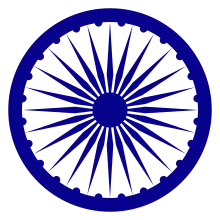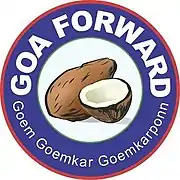| This article is part of a series on the |
| Politics of India |
|---|
 |
|
|
India has a multi-party system. The Election Commission of India (ECI) accords to national-level and state-level political parties based upon objective criteria. A recognised political party enjoys privileges like a reserved party symbol,[lower-alpha 1] free broadcast time on state-run television and radio, consultation in the setting of election dates, and giving input in setting electoral rules and regulations. Other political parties that wish to contest local, state, or national elections are required to be registered by the Election Commission of India. Registered parties are upgraded as recognised national parties or state parties by the ECI if they meet the relevant criteria after a Lok Sabha or state legislative assembly election. The recognised party status is reviewed periodically by the ECI.
Before the amendment in 2016 (which came into force on 1 January 2014), if a political party failed to fulfill the criteria in the subsequent Lok Sabha or state legislative assembly election, they lost their status as a recognised party. In 2016, the ECI announced that such a review would take place after two consecutive elections instead of every election. Therefore, a political party shall retain the recognised party status even if they do not meet the criteria in the next election. However, if they fail to meet the criteria in the subsequent election following the next election, they would lose their status.
As per latest publications dated May 2023 from Election Commission of India, and subsequent notifications, there are 6 national parties,[1] 55 state parties,[2][lower-alpha 2] and 2,597 unrecognised parties.[3] All registered parties contesting elections need to choose a symbol from a list of available symbols offered by the EC. All 28 states of the country along with the union territories of Jammu and Kashmir, National Capital Territory of Delhi, and Puducherry have elected governments unless President's rule is imposed under certain condition.
National parties
A registered party is recognised as a national party only if it fulfils any one of the three conditions listed below:[4]
- The party wins two per cent of seats in the Lok Sabha from at least three different states.
- At a general election to Lok Sabha or Legislative Assembly, the party polls six per cent of votes in any four or more states and in addition it wins four Lok Sabha seats.
- The party gets recognition as a state party in four states.
State parties
A registered party is recognised as a state party only if it fulfils any one of the five conditions listed below:[4]
- A party should secure at least six per cent of valid votes polled in an election to the state legislative assembly and win at least two seats in that state assembly.
- A party should secure at least six per cent of valid votes polled in an election to Lok Sabha and win at least one seat in Lok Sabha.
- A party should win at least three per cent of the total number of seats or a minimum of three seats in the Legislative Assembly, which ever is higher.
- A party should win at least 1 seat in the Lok Sabha for every 25 seats or any fraction thereof allotted to that state.
- Under the liberalised criteria, one more clause that it will be eligible for recognition as state party if it secures eight per cent or more of the total valid votes polled in the state.
Unrecognised parties
See also
Notes
- ↑ If a party is recognised as a national or state party, its symbol is reserved for its exclusive use in the country or in the state.[1][2]
- ↑ There were 57 state parties listed in publication issued by the Election Commission of India on 15 May 2023. However 2 out of 57 parties (Rashtriya Lok Samata Party and People's Democratic Front) have merged with other parties.
References
- 1 2 3 "List of National Parties". Election Commission of India. 15 May 2023. Retrieved 19 May 2023.
- 1 2 3 "List of State Parties". Election Commission of India. 15 May 2023. Retrieved 19 May 2023.
- 1 2 "List of RUPPs". Election Commission of India. 15 May 2023. Retrieved 19 May 2023.
- 1 2 "The Election Symbols (Reservation and Allotment) Order, 1968". Election Commission of India. Retrieved 3 October 2022.
- 1 2 "Lok Sabha Elections 2014: Know your party symbols!". Daily News and Analysis. 10 April 2014.
- ↑ "AIADMK". The Times of India. Retrieved 14 September 2023.
- ↑ Ogden, Chris (20 June 2019). A Dictionary of Politics and International Relations in India. Oxford University Press. ISBN 978-0-19-253915-1. Archived from the original on 9 March 2023. Retrieved 11 November 2022.
All India Anna Dravida Munnetra Kazhagam (Tamil: 'All India Anna Dravidian Progress Federation') A political party. It was established in 1972...
- ↑ Price, P. (1996). Revolution and Rank in Tamil Nationalism. The Journal of Asian Studies, 55(2), 359-383. doi:10.2307/2943363
- ↑ Pamela Price (1999) Relating to leadership in the Tamil nationalist movement: C.N. Annadurai in person‐centred propaganda, South Asia: Journal of South Asian Studies, 22:2, 149-174, doi:10.1080/00856409908723369
- 1 2 Kannan, Ramya (8 August 2018). "M. Karunanidhi: From health care to community living, his schemes were aimed at social equality". The Hindu. ISSN 0971-751X. Retrieved 10 August 2019.
- "Social Equality was Karunanidhi's Focus During Five Terms as Tamil Nadu CM". News18. 11 March 2019. Retrieved 10 August 2019.
- ↑ "Tumultuous transition". 27 May 2017.
- ↑ "Why no centre-right political party in India today?". 16 February 2014.
- 1 2 "Encyclopedia Britannica".
- ↑ Price, Pamela; Srinivas, Dusi (August 2014). Piliavsky, Anastasia (ed.). "Patronage and autonomy in India's deepening democracy". Cambridge University Press: 217–236. doi:10.1017/CBO9781107296930.011. ISBN 9781107296930.
- ↑ "Party constitution". India: All India Forward Bloc. 2017. Retrieved 22 April 2017.
- ↑ "Though BJP and AIMIM are ideologically apart they share a few similarities".
- ↑ "Will fight back to save India's composite culture, Constitution: Asaduddin Owaisi". 26 May 2019.
- ↑ "Minority Upliftment".
- ↑ "AIMIM eyes minorities and Dalits in Malda".
- ↑ "AIMIM want to confront Hindu nationalism with Indian Constitution: Owaisi". Business Standard India. 8 February 2021.
- ↑ "Centrist polity of TRS".
- ↑ Hyderabad, K. VENKATESHWARLU in (23 April 2004). "Regionalism and sub-regionalism". Frontline. Retrieved 14 September 2020.
- ↑ "One year of Telangana a mixed bag for KCR". The Tribune. Archived from the original on 21 July 2018. Retrieved 20 July 2018.
The Telangana Rashtra Samithi (TRS), led by Chandrasekhar Rao, took over the reins of the new state amid euphoria and high expectations. ... Blending boldness with populism, KCR has earned the reputation for being a tough task master
- 1 2 "Biju Janata Dal". Encyclopædia Britannica.
- ↑ "Lok Sabha Elections 2014: Know your party symbols!". Daily News and Analysis. 10 April 2014.
Founded in December 1997, the Biju Janata Dal or the BJD is a regional political party of India. Having split from the larger faction Janata Dal, the party stands by democracy and liberalism.
- ↑ Capron, Laurence; Guillén, Mauro (12 October 2006). "Fighting economic nationalism in deals". Financial Times. Archived from the original on 10 December 2022. Retrieved 22 May 2018.
- ↑ "IDEOLOGY & FLAG". India: Election Commission of India. 2013. Archived from the original on 26 October 2020. Retrieved 9 May 2013.
- 1 2 "General Programme of CPI(ML)". Communist Party of India (Marxist-Leninist) website. 6 April 2013. Archived from the original on 8 April 2020. Retrieved 23 March 2020.
- ↑ "A coloured scheme of things". Archived from the original on 19 July 2023.
- 1 2 "History". JK Panthers Party. Archived from the original on 13 April 2020. Retrieved 26 September 2015.
- 1 2 PTI (9 November 2010). "SC upholds freeze on delimitation in J&K till 2026". The Hindu.
- ↑ "Headlines Today". Panther party MLAs disrupt house in Jammu and Kashmir assembly. 28 August 2014. Retrieved 26 September 2015 – via youtube.com.
- ↑ Jammu Kashmir Peoples Democratic Party. "Self Rule". Retrieved 16 October 2020.
- ↑ "KM Mani: The man behind the 'Theory of the Toiling Class'". The New Indian Express. 10 April 2019. Retrieved 20 March 2021.
- ↑ "K M Mani honoured at British Parliament Hall". The New Indian Express. 7 September 2012. Retrieved 20 March 2021.
- ↑ "Raj Thackeray goes right ahead with 'Hindutva'and development agenda for MNS". CanIndia. 23 January 2020. Archived from the original on 19 May 2021. Retrieved 28 October 2021.
- ↑ Bedi, Tarini (2016). The Dashing Ladies of Shiv Sena. SUNY Press. p. 42.
- ↑ "Munde still keen on alliance with MNS". Hindustan Times. 2 March 2011.
- 1 2 3 "Maharashtra Navnirman Sena". Election MS. 29 March 2019.
- ↑ "How Pakistan Fell in Love With Bollywood". Foreign Policy. 15 March 2010.
- ↑ Bidyut Chakrabarty (2014). Communism in India: Events, Processes and Ideologies. Oxford University Press. p. 61. ISBN 978-0-19-997489-4.
- ↑ "Indian citizenship act against humanity: Manoj Bhattacharya". prothomalo.com. March 2020.
- ↑ Verniers, Gilles (2018). "Conservative in Practice: The Transformation of the Samajwadi Party in Uttar Pradesh". Studies in Indian Politics. 6: 44–59. doi:10.1177/2321023018762675. S2CID 158168430.
- ↑ "Left wing triumphs in Uttar Pradesh election". Financial Times. 6 March 2012. Archived from the original on 10 December 2022.
The big winner in the Uttar Pradesh state election was the regional leftwing Samajwadi party
- ↑ "Indian MPs held hostage in caste struggle". The Independent. 21 June 1995.
- ↑ Singh, Mahendra Prasad; Saxena, Rekha (2003). India at the Polls: Parliamentary Elections in the Federal Phase. Orient Blackswan. p. 78. ISBN 978-8-125-02328-9.
- ↑ "Mulayam's son Prateek Yadav attracts eye balls during ride in Rs 5 crore Lamborghini". Zee News. 14 January 2017.
- ↑ "SAD aims to widen reach, to contest UP poll". The Tribune. Chandigarh. 8 October 2015. Retrieved 8 October 2015.
- ↑ Pandher, Sarabjit (3 September 2013). "In post-Independence India, the SAD launched the Punjabi Suba morcha in the 1960s, seeking the re-organisation of Punjab on linguistic basis". The Hindu. Retrieved 15 September 2015.
- ↑ Grover, Verinder (1996). Encyclopaedia of India and Her States: Himachal Pradesh, Jammu & Kashmir and Punjab, Volume 4. Deep & Deep. p. 578.
- ↑ "Parkash Singh Badal calls for 'genuinely federal structure' for country". The Economic Times. 7 December 2014. Retrieved 10 October 2019.
- ↑ Bharti, Vishav (6 August 2019). "Article 370: SAD 'dumps' its core ideology of federalism". The Tribune. Retrieved 10 October 2019.
- ↑ "This is how Jagan Reddy has turned into a political juggernaut in Andhra". 25 September 2021.
- ↑ "Manjhi's HAM recognised by poll panel". The Statesman. 19 July 2015. Retrieved 25 November 2016.
- ↑ "Allotment of Common Symbol -10B letter dt 15.9.15" (PDF). Election Commission of India. 15 September 2015. Retrieved 25 November 2016.
- ↑ "June 2015 Notification" (PDF). Election Commission of India. p. 2. Retrieved 17 September 2016.
- ↑ "महंगाई व बेरोजगारी के खिलाफ किया प्रदर्शन". www.livehindustan.com. Retrieved 7 May 2021.
- ↑ "SAMATA PARTY – Official Website". Archived from the original on 15 February 2022. Retrieved 8 February 2022.
==
Further reading
- Subrata K. Mitra and V. B. Singh. 1999. Democracy and Social Change in India: but parties have to be 70per of decision A Cross-Sectional Analysis of the National Electorate. New Delhi: Sage Publications. ISBN 81-7036-809-X (India HB) ISBN 0-7619-9344-4 (U.S. HB).
- Subrata K. Mitra, Mike Enskat, Clemens Spiess (eds.). 2004. Political Parties in South Asia. Greenwood: Praeger.
- Political Parties, Democratic Politics II, Textbook in Political Science for Class X, NCERT




















